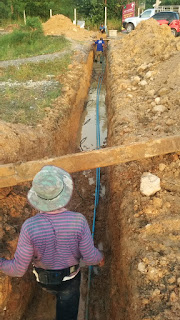The past few days have been hectic.
We added a second water main pipe just for redundancy. (It will remain unused until we detect a problem in the first pipe at some point in the future.) But that was the easy part.
On the last day that we had the excavator rented, we needed to close up the trench. But it occurred to me at the last minute that although we don’t use land line phones, we do use ADSL. Arghh!
So we needed to send someone out to buy telephone drop wire at the last minute. We decided to also pick up some outdoor CAT5e cable. We buried them in HDPE pipes and ran them along the same trench. The power and water lines are 1m deep, and the communications lines are about 50cm deep, so there should be enough separation between the communication lines and the power lines to prevent interference.
Here is a picture of the running of the power lines. You can see the double water pipes on the right side of the trench and the 16mm2 NYY 2 cunductor power cable laid out loosely on the left side. Note despite the rainy season ending, we got a bit unlucky with a rain storm passing through while we were laying the utilities in the trench. So it got quite muddy.
The NYY cable has a hardened sheeth and is designed to go into the ground directly without any pipe around it. (In fact, a pipe reduces its ability to release heat and results in it being derated with regards to the maximum amps that the wire can safely conduct.) But it is still important to lay the wire loosely and give it enough slack so that any settling of the ground doesn’t result in excessive strain on the cable. To aid in this, we added two cement boxes to allow some extra coil in the wire, one at the bend and another along the longer run.
 |
| Coil of wire inside cement box |
 |
| Cement box sealed up and ready for filling in the soil |
After that, we began filling in the trench:
When the trench was filled half way up, we added the communications cables in the HDPE pipe and then filled the trench in the rest of the way.
Now it looks like this:
In the distance, where the end of the pipe used to be, is where all the pipes and cables come out to be connected to the utility companies. Here is a closer picture:
On the right side you can see the two blue PVC water pipes. On the left, you can see a length of the NYY main power cable coming out of the ground. And if you look carefully, to the right of the PVC pipes, you can see two HDPE pipes coming out of the ground, one holding the telephone drop wire and the other holding the outdoor CAT5e cable.
On the other side by the house:
The HDPE pipes for the communication wires come out of the ground by the left cement house support footing. In the middle is where the water pipes come out. And at the foot of the right cement footing, the NYY cable comes out.
We will still need to add a metal junction box to feed the communication wires into and mount it to the left cement footing. The water pipes will come out of a cement platform that will hold the main clean water tank and house water pump. And another junction box will be mounted to the right cement footing for the electrical power lines to connect the the lines that go into the house.
Additionally, we will be driving several copper grounding rods into the ground (3 meters apart) along the trench, so we didn’t fully fill in the trench on the right side.




